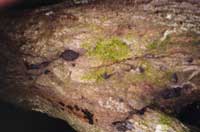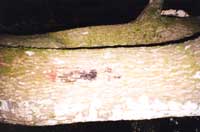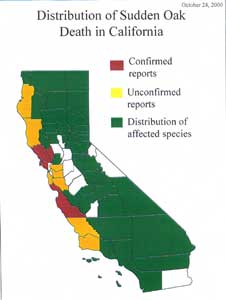|
A Threat
to Oakland’s Namesake:
Scientists Wonder When Deadly Disease Will Hit Local Oak Trees
By Munira Syeda
Photos
by Nina Maggi Kelly
Pointing to a leafless oak tree in the Mount Tamalpais watershed, Marin
County forester Kent Julin said, "Here’s another dead one."
The tree was a coast live oak whose bark had turned black, and some of
its thick branches had fallen off.
This oak is one of tens of thousands of oak trees that have died in Marin
County in the past 5 years because of a new disease scientists still don't
know much about.
Referred to as Sudden Oak Death (SOD), the disease is caused by the fungus
Phytophthora. It has been given this name because a healthy-looking tree
suddenly turns its leaves brown and then dies, even though it may have
been infected for more than a year.
SOD has spread to five Northern California counties since it was first
discovered in Mill Valley in 1995 by a horticulturist Pavel Svihra. It
has struck as far as Sonoma county in the north and Monterey county in
south.
Phytophthora seems confined to oaks along the coast. It favors moisture
and cool temperatures. The farthest infected oaks have been found thirty
miles inland, in Napa County.
So far, three kinds of oaks have been attacked -- coast live oak, black
oak and tanoak. Tanoak is not a true oak, however. An estimated 10 to
11 million acres of oaks line the 1500 mile stretch of California and
Oregon coast.
Phytophthora is related to the fungus that caused the Irish potato blight
during the 19th century. SOD may drastically change the landscape of California
forests and urban regions. It may affect wildlife habitat and bring homeowners
financial ruin.
With the threat of SOD looming, the city of Oakland appears unaffected
so far. No infected oaks have been discovered here yet. But local tree
experts say the relief from SOD may be short-lived.
"Everybody is holding their breath," said Nancy Brownfield,
pest management coordinator at East Bay Regional Parks District. "Oakland
is called ‘Oakland’ for a reason."
There are more than a hundred parks managed by the city, said Oakland
Parks and Recreation Department tree supervisor Dan Gallagher, and oak
trees grow in most of those parks. Coast live and black oaks are natives,
and although Gallagher said there is no way to count the city’s total
number of oaks, they are scattered everywhere, particularly in Joaquin
Miller Park, the largest park managed by Oakland.
Brice McPherson, an entomologist at UC Berkeley, said he became suspicious
of some oaks while hiking recently in the East Bay. "Nowadays, I
can't go into any forest or historical park without checking the oak trees
carefully," he said.
McPherson said he plans to visit the site next week to get tree samples
and test them in the lab. Sometimes, other pathogens can give similar
symptoms as SOD, he said. McPherson said he would share the East Bay location
if the lab tests came out positive.
McPherson is a member of the Oak Mortality Task Force, a state level effort
to get a grip on this disease. The Task Force has received $100,000 from
Governor Gray Davis so far. Their budget, however, is $5 million.
An infected coast live or black oak looks green and healthy until it is
almost dead. First, Phytophthora attacks tree bark, which results in sap
bleeding in the bottom of the tree. This cuts off the nutrient supply,
weakening the tree and making it susceptible to other pests such as Ambrosia
beetles.
These beetles bore thousands of holes in the trunk of the sick tree, which
collectively cuts off the water supply. They lay their eggs and also leave
another fungus, Ambrosia, in the form of spores, as a food supply for
their young. Soon afterward, the leaves turn brown. During this time,
another fungus called Hypoxylon attacks oak tree and forms black, dome-shaped
fruiting bodies on the trunk.
Tanoaks exhibit the same symptoms. In addition, the leaves droop and and
little sprouts called suckers pop up at the base of the tree after it
dies.
SOD may not have arrived in Oakland, but Marin is being called a hotspot.
In China Camp State Park, with an area of 1640 acres in Marin county,
60% to 70% of Oak trees are dead or infected, Julin said. Some of these
oaks are 300 to 500 years old, said Andrew Storer, an entomologist at
UC Berkeley.
UC Davis pathologist Dave Rizzo discovered the fungus, which doesn’t
match any of the 60 known species world-wide. The culprit is a new strain,
but scientists believe that the infectious species closely resembles the
pathogen that killed thousands of Port Orford cedars in northern California
during the 1960s.
Gallagher said he believed the fungus tended to be species-specific. So
it may stick to the three species already under attack, but there are
no guarantees. There are roughly 19 species of oaks in California, and
more than 300 world-wide.
The two pathogens infecting the oaks and cedars have spores with tails.
Called zoospores, they have the ability to swim in water—after a
rainfall, for example—and spread from tree to tree. Thus, the scientists
theorize that the pathogen infecting the oaks is water-borne. Scientists
also think Phytophthora may be carried both in soil and in the air.
Storer said the fungus may potentially spread from dirt on people's boots
or from insects and animals. So a hike in Marin might bring the fungus
home to Oakland.
Newly said his department had received no reports of infected oaks in
Alameda county. If a diseased oak tree did turn up, his department would
get a warning message from the California Dept. of Food & Agriculture,
Newly said.
Oak trees, which are part of California’s history and aesthetics,
are also critical to animals. Forester Kent Julin said the deer, squirrel,
and acorn woodpecker are at risk of losing food and habitat.
"A mule deer, for example, may eat over 300 acorns per day during
October; for weeks this single source may constitute over half of its
daily food intake," Julin said, quoting from the book, ‘The
Oaks of California.’
Homeowners are concerned about SOD as well. They "are emotionally
connected to trees," and are distraught about the infection, Julin
said. Healthy oaks can add from $10,000 to $30,000 to the value of a home,
he said.
If the trees die of SOD, Kelly's recommendation is, "Cut it down
and keep the wood on site." Scientists want to reduce the spread
of the disease and feel that moving diseased wood around may infect other
healthy oaks, Storer said. Using the dead wood for fires was safe, he
said.
This means homeowners are additionally burdened by the cost of chopping
the wood. A small tree, with a 12 inch diameter (the size of a ruler),
costs about $500 to cut down, Julin said. But a large tree, with a 3 ft
diameter, may cost as much as $4,000, Julin said.
Even though pesticides or fungicides are not recommended, some brand names
have been put on the website, http://cemarin.ucdavis.edu/ Storer said
the scientists wanted to inform citizens of the pesticides that targeted
Phytophthora or ambrosia beetles. The pesticides listed are Phyton-27,
Astro & Dragnet SFR, and Subdue MAXX.
Marin county officials are concerned about the fire hazards posed by dry,
dying oaks. A report published by the county fire department says an infected
tree loses nearly half its moisture, turning the tree into prime fire
fuel.
The Marin Municipal Water District, which Julin visited, delivers water
to three-quarters of households in Southern Marin, he said. An absence
of trees would increase erosion of the soil as well as sedimentation in
the Marin watershed, potentially reducing the storage capacities of the
reservoirs, "Sedimentation could result following a large-scale fire
in the watershed," Julin said.
Kelly and Julin warned about symptoms identifying the oak disease, saying
other diseases can have similar symptoms as well. For example, an over-watered
oak can exhibit sap bleeding in the early stages, Storer said.
"Over-watering encourages the growth of oak root fungus, Armillaria,
which can cause leaves to turn brown and fall prematurely," Julin
said.
Kelly and Julin strongly recommended having an official inspect the tree,
before cutting it down.
Sudden oak death is probably the worst disease that oaks have faced in
the last twenty years, Storer said. In the past, trees have been wiped
out by other diseases. Pitch canker on pine trees, Dutch elm disease,
and white pine blister rust on white pines -- these were infections caused
by exotic agents. Scientists have yet to find if the new strain an exotic
or rather a dormant species which has just made its debut.
For more information, please check out these websites:
http://camfer.cnr.berkeley.edu/oaks
http://cemarin.ucdavis.edu/
http://frap.cdf.ca.gov/oak_mortality
http://www.cnr.berkeley.edu/forestry
http://www.suddenoakdeath.org
Home
|

A
coast live oak (quercus agrifolia) in the Mt. Tamalpais watershed in Marin
county. The black, dome shaped hypoxylon fruting bodies on the tree trunk
are one symptom of sudden oak death.

Another
coast live oak (quercus agrifolia) in Mt. Tamalpais watershed in Marin
County shows sap bleeding on the trunk, another symptom of sudden oak
death.

Map
and Photos courtesy of the College of Natural Resources Center for the
Assessment and Monitoring of Forest and Environmental Resources (CAMFER)
http://camfer.cnr.berkeley.edu
|

